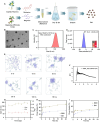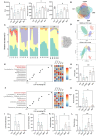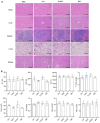Berberine and magnolol exert cooperative effects on ulcerative colitis in mice by self-assembling into carrier-free nanostructures
- PMID: 39227962
- PMCID: PMC11373475
- DOI: 10.1186/s12951-024-02804-x
Berberine and magnolol exert cooperative effects on ulcerative colitis in mice by self-assembling into carrier-free nanostructures
Abstract
The risk of ulcerative colitis (UC) is increasing worldwide with limited success using classical drugs, which has underscored the development of novel agents. Recently, carrier-free molecular assembly has been proven to be an effective drug delivery system, but it has yet to be examined for UC drug development using phytochemicals. Based on traditional Chinese medicine compatibility and potential medicinal uses, a pair of natural compounds, berberine (BBR) and magnolol (MAG), were found to self-assemble into nanostructures in aqueous solutions. Spectral analysis revealed that the assembly mechanisms of BBR and MAG were mediated through charge interactions and π-π stacking. Pharmacokinetic studies and animal imaging showed that BBR-MAG self-assembly (BM) effectively promoted the oral bioavailability and biodistribution of BBR in the colon. BM exhibited superior effects in regulating inflammatory factors, maintaining colon barrier integrity, and regulating gut microbiota in a dextran sulfate sodium salt-induced colitis mouse model. Additionally, no apparent signs of toxicity were observed, suggesting that BM has a favorable safety profile. This study presents a new strategy for UC management and highlights the cooperative effects of combined phytochemicals.
Keywords: Berberine; Gut microbiota; Magnolol; Self-assembly; Ulcerative colitis.
© 2024. The Author(s).
Conflict of interest statement
The authors declare no competing interests.
Figures







References
-
- Tian Y, Tang G, Gao Y, Chen X, Zhou Z, Li Y, Li X, Wang H, Yu X, Luo L, et al. Carrier-free small molecular self-assembly based on berberine and curcumin incorporated in submicron particles for improving antimicrobial activity. ACS Appl Mater Interfaces. 2022;14(8):10055–67. 10.1021/acsami.1c22900 - DOI - PubMed
-
- Huang XM, Wang PL, Li T, Tian XH, Guo WB, Xu B, Huang GR, Cai DS, Zhou F, Zhang H, et al. Self-assemblies based on traditional medicine berberine and cinnamic acid for adhesion-induced inhibition multidrug-resistant Staphylococcus aureus. ACS Appl Mater Interfaces. 2020;12(1):227–37. 10.1021/acsami.9b17722 - DOI - PubMed
-
- Wang P, Guo W, Huang G, Zhen J, Li Y, Li T, Zhao L, Yuan K, Tian X, Huang X, et al. Berberine-based heterogeneous linear supramolecules neutralized the acute nephrotoxicity of aristolochic acid by the self-assembly strategy. ACS Appl Mater Interfaces. 2021;13(28):32729–42. 10.1021/acsami.1c06968 - DOI - PubMed
MeSH terms
Substances
Grants and funding
LinkOut - more resources
Full Text Sources
Medical
Research Materials
Miscellaneous

